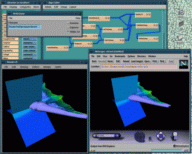Sharing 3D from IRIS Explorer: New options for VRML 2.0 output
The past months have seen a heightened level of interest in the Virtual
Reality Modelling Language (VRML)
(External)
as the standard for 3D data interchange on the Web. Since its introduction
as VRML 1.0 in 1995 and the appearance of VRML 2.0 last summer, the number
of sites which offer 3D content has increased dramatically, in a fashion
that parallels the explosive growth in Web activity. The ability to share
representations of data as navigable 3D scenes on the Web is a valuable
enhancement to traditional methods of publishing results. The extra understanding
that comes from being able to interact with and steer through a complex
3D scene (which is harder to do with a static image as published in, say,
a journal) has already been appreciated by many people.
The original basis for VRML was the file format defined by Open
Inventor (External), the object-oriented, OpenGL-based
(External) 3D toolkit originally from Silicon Graphics (External).
As many users know, this is also one of the libraries underpinning IRIS
Explorer; in fact, the geometry data type in IRIS Explorer is synonymous
with an Open Inventor scene graph. This means that it is particularly easy
to convert scenes created in IRIS Explorer into VRML, and so publish them
on the Web.
 Developers
at NAG are currently working to make this conversion process even more
transparent by modifying the
WriteGeom
module (which currently outputs geometry in either the Inventor
format or the IRIS Explorer shared geometry format which was introduced
at version 3.0) to output scenes in VRML 2.0 format. In addition, a new
module called CombineGeom has been developed to take the
input from several geometry modules on its input port (this is known as
fan-in) and combine them together into a single scene. Using these two
modules, users can save as much of their map's geometry into a VRML 2.0
file as they require.
Developers
at NAG are currently working to make this conversion process even more
transparent by modifying the
WriteGeom
module (which currently outputs geometry in either the Inventor
format or the IRIS Explorer shared geometry format which was introduced
at version 3.0) to output scenes in VRML 2.0 format. In addition, a new
module called CombineGeom has been developed to take the
input from several geometry modules on its input port (this is known as
fan-in) and combine them together into a single scene. Using these two
modules, users can save as much of their map's geometry into a VRML 2.0
file as they require.
Keep watching the IRIS
Explorer Center's website (External) for details of the release of the new modules
on all platforms for which IRIS Explorer 3.5 is available. Finally, those
interested in VRML 2.0 may like to read a recent NAG Technical Report:
"Rock
'n' Roll: Using VRML 2.0 for Visualisation" (External), which was presented
at the 8th Eurographics
Workshop on Visualisation in Scientific Computing in April. The paper
reviews some of the new features in VRML 2.0, presents examples of visualisations
which make use of these enhancements and outlines ways in which the language
could be usefully developed in the future. The paper is available
as HTML (External)
or PostScript (External)
from the IRIS Explorer
Technical Reports page (External), or can be obtained as hard copy by contacting
the IRIS Explorer Center.
Last modified: Mar 16 10:45 1999
[ Contents :
Previous Article :
Render Home :
Next Article
]
© The Numerical Algorithms Group Ltd, Oxford UK. 1999
 Developers
at NAG are currently working to make this conversion process even more
transparent by modifying the
WriteGeom
module (which currently outputs geometry in either the Inventor
format or the IRIS Explorer shared geometry format which was introduced
at version 3.0) to output scenes in VRML 2.0 format. In addition, a new
module called CombineGeom has been developed to take the
input from several geometry modules on its input port (this is known as
fan-in) and combine them together into a single scene. Using these two
modules, users can save as much of their map's geometry into a VRML 2.0
file as they require.
Developers
at NAG are currently working to make this conversion process even more
transparent by modifying the
WriteGeom
module (which currently outputs geometry in either the Inventor
format or the IRIS Explorer shared geometry format which was introduced
at version 3.0) to output scenes in VRML 2.0 format. In addition, a new
module called CombineGeom has been developed to take the
input from several geometry modules on its input port (this is known as
fan-in) and combine them together into a single scene. Using these two
modules, users can save as much of their map's geometry into a VRML 2.0
file as they require.